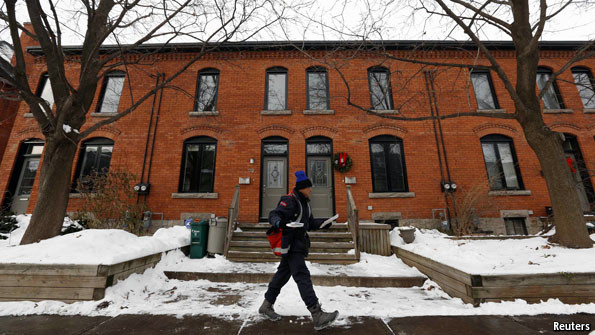IN A move that now seems like subliminal messaging, Canada Post celebrated the 100th anniversary of the Canadian postal service in 2012 by issuing a special set of stamps featuring the Royal Mail Ship Titanic. The drastic changes announced by postal management this week, the most significant of which is the eventual elimination of home delivery, are meant to avert disaster.
Canada Post has been hit by a familiar story: rising electronic communication and declining volumes of letters. The decline did not start until 2007 but has picked up astonishing speed, with 1 billion fewer letters delivered in 2012 than in 2006. Canada is the first of the Group of Seven countries to signal the end of home delivery but it will almost certainly not be the last. Globally, the volume of letters posted has been sliding for a decade, dropping by 4.7% between 2011 and 2012 to 346.5bn items; a further 4% global decline is expected this year.
Parcel deliveries are still on the rise, both globally and domestically, but the gains have not been enough to offset the losses Canada Post is incurring on its letter-delivery business. The Crown corporation faces the added disadvantage of having most of its 15m customers strung out in a 6,400km line just above the Canada-US border. The number of new customers keeps growing at a rate of well over 100,000 a year. Something had to give and with the announcement on December 11th, it did.
Home delivery to the 5m households who still receive it will be phased out over four years, beginning in 2014. They will join the 3.8m households that already go to a group mailbox to collect mail and parcels. The remaining customers get their mail from boxes in building lobbies (3.8m), public and private post offices (1.8m), or from a rural mailbox (0.8m). The plans also calls for up to 8,000 postal workers to be cut from a total staff of about 55,000, a 35% leap to C$1 in the price of a stamp and the use of more technology and more franchise postal outlets.
Critics blasted the Conservative government for picking on the disabled and the elderly, who face a bone-chilling winter walk to get their mail. (As your correspondent writes this the temperature in Ottawa is -15C, comparatively balmy compared with -40C in Yellowknife in the Northwest Territories.)
But government ministers had their lines ready. Peter Van Loan, the government leader in the House of Commons, compared those complaining about the end of home delivery to the residents of the posh Rosedale neighbourhood (Toronto’s answer to London’s Mayfair), who moaned when they were forced to bring their rubbish to the curb for pickup rather than having the rubbish men walk up the driveway to collect it. The Conservatives are on politically safe ground, because most of the 5m households that will lose home delivery are in urban districts held by the opposition New Democrats or the Liberals.
Other critics may be harder to ignore. Michael Warren, the first head of Canada Post after it was made a Crown corporation, says it could have been privatised years ago when it was still profitable. It was also relatively debt-free at the time but has since added C$1bn in loans to its estimated pension shortfall of C$6bn. According to Mr Warren, a privatisation plan was presented to the government in 2008 but was rejected because the Conservatives did not want to jeopardise their then minority government by embarking on something so controversial. The CEO at the time was Moya Greene, who left Canada for Britain in 2010 and led this year’s privatisation of the Royal Mail.
Canada Post may yet be sold but its mounting losses and excessive debt will deter some potential purchasers. The Canada Post Group of Companies posted a slim profit of C$94m on revenues of C$7.5bn in 2012 because of extraordinary items. It anticipates a loss in 2013. Projected savings of between C$700m and C$900m a year by 2020 from the changes announced this week will help, but the costs of implementing the reforms were noticeably missing from the numbers. Eliminating home delivery, for example, is expected to save C$500m a year, but there are no figures for buying and installing the new group mailboxes required. Canada Post is altering course but safe passage is not yet assured.
Original Article
Source: economist.com/
Author: -

No comments:
Post a Comment